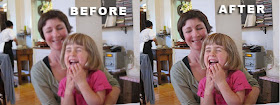Every photographer knows the disappointment of taking a great photograph only to find the picture was ruined by camera shake or the subject moving.
Such photographs cannot be brought back to crisp focus but they can be improved using software that employs an advanced mathematical technique called deconvolution to try to undo the blur. Deconvolution is widely used in many areas of signal processing such as reducing the severity of echoes in long distance phone conversations.
The best deconvolution software for deblurring photos is commercial but there is a program called Unshake that can produce good results and is free for private use.
To get the best out of Unshake you need to do quite a bit of trial and error testing to determine which parameter settings yield the most acceptable results. Most of the time the improvement is considerably better than that obtainable by using simple sharpening filters like those that can be found in digital editing software such as Photoshop; it all depends on the nature of the blur in a particular photograph.
Unshake does not require installing as it's a Java program and will run on any computer including Windows, Macs and Linux boxes that have Sun Java installed.
On a Windows PC you need to unzip the download file to a folder then run the program called "launch" from that folder.
The interface is simple enough but usage requires experimentation. In particular you will need to play around with the settings in the two drop boxes at the top as well the amplification setting below. I strongly recommend that you read the file Instructions.html contained in the product folder before using the product.
Because Unshake is written in Java it runs quite slow – a 10 megapixel photo may take 5-10 minutes to process. For that reason I suggest you do your experimentation on a reduced size image (PNG format works best) and then process the full scale picture once you've worked out what settings give the best results. I used 1024*768 images for my testing and Unshake was able to process these images in 10-15 seconds.
So what results can you expect?
If you are using the results for forensic purposes such as deblurring a car license plate then you will be pleasantly surprised. That's because image clarity is important in these applications not image quality.
With normal landscape and portrait photos the results are less spectacular as too much deblurring results in increased noise artifacts and unpleasant etching. Still the results are usually considerably better than using sharpening filters in a digital editor. Here is a before and after sample photo I processed with Unshake.
Unshake is not a tool that you will use everyday but is a handy addition to your toolkit should you need to improve a valuable photograph that can not be replaced.
So next time you find a wonderful photo that's been blurred by movement, do try Unshake. You may be pleasantly surprised at the results.
Unshake Version 1.5 Release 1
Download link: Unshake Download
System requirements: Works on any Windows, Mac or Linux system with Sun Java installed.
Saturday, 9 June 2012
Fix the blurred photos
via: www.techsupportalert.com
For non-commercial use only

















0 comments:
Post a Comment